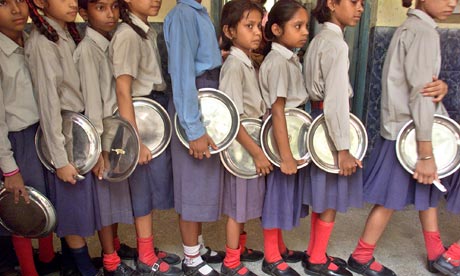
(MintPress) – While more than 925 million people worldwide are undernourished, Americans consume nearly 815 billion calories of food each day. That is equal to 200 billion more calories than needed – enough to feed the entire populations of Ecuador, Ivory Coast, Taiwan and Sri Lanka combined.
The United States produces more than 75 million tons of food each year, including meat, dairy and crops. Even so, the country imports approximately 15 percent of its food, based on volume. Meat, fish, dairy and produce are imported from countries around the world, including China, Mexico, Chile and India. The increase in availability of food has aided in the escalated rate of Americans who are overweight or obese, which is now at 66 percent.
In comparison, in India, food production exceeds 200 million tons each year, including meat, grains and fish. Yet it is estimated that more than 60 million children live without regular access to food. While India imports nearly $2.1 billion worth of food and live animals, its exports are almost 4 times as high, at $8.2 billion. According to a recent study by Save the Children, nearly 500 million children worldwide are at risk to suffer from malnutrition within the next 15 years.
The U.S. imported nearly $94.5 billion worth of agricultural products in 2011, according to the United States Department of Agriculture (USDA). Of that, more than $41.7 billion came from 11 developing countries, including Mexico, China, Brazil, Indonesia, Chile, Thailand, Columbia, Malaysia, India, Guatemala and Costa Rica. Combined, these 11 countries are estimated to have more than 424 million citizens living in an undernourished state.
The International Labour Organization (ILO) estimates that more than 1.3 billion workers worldwide are employed through the agricultural sector. Of this, less than 2 percent live in developed countries, and it is estimated that more than half of the food grown worldwide is produced by rural women in developing countries.
Investment in developing countries
Since 2007, the overall price of food has risen more than 6 percent, with prices in 2012 projected to increase an additional 2.5-3.5 percent. With global food prices increasing, developed countries are looking for ways in which food can be produced at a cheaper cost.
An increasing number of nations have been expanding their production to foreign countries in order to increase product sales there. In developing countries in Africa, Latin America and Asia, foreign direct investment (FDI) rates have been increasing, with total FDI inflows of $549.1 billion in 2008. In this system, items are produced with the intent to be sold in the country in which they were made so that the host country’s citizens can benefit from production.
In comparison, countries can invest in land to produce goods in order to export the food out of the country they are produced in. While richer countries develop the land and harvest produce, the host countries do not share in the nutritious wealth that comes from the crops. Instead, the produce is exported to the investor country.
“While two thirds (105) of the 148 developing countries are net food importers, two fifths (63) are net agricultural exporters, including 33 low-income countries. It also shows that at least 28 of the low-income food deficit countries are in fact net agricultural exporters.” Alex F. McCalla, professor Emeritus of Agriculture Economics, Department of Agriculture and Resource Economics, University of California, Davis.
The effect on the border
The U.S. is Mexico’s largest agri-food trading partner, buying 77 percent of Mexico’s exports. In 2011, the United States imported nearly $15.5 billion in agricultural goods from Mexico, including cocoa, coffee, dairy, fruit, grains, meats, nuts, sweeteners and vegetables.
According to the World Bank, 52.9 percent of the land in Mexico is classified as agricultural land, defined as land that is arable, under permanent crops and under permanent pastures. Approximately 6.4 million people in the Mexican work force deal in the agricultural sector, accounting for 30 percent of men and women workers over the age of 18 in Mexico.
However, children under 15-years-old account for 20 percent of Mexico’s migrant farm workers. Many of these workers begin before age 10. Of the children workers, it is estimated that 42 percent suffer from malnutrition.
Gaining from those suffering
The number of Americans classified as overweight or obese is increasing at a staggering rate, with more than one-third of the adults in the United States overweight and an additional one-third in the obese range. Additionally, according to the Centers for Disease Control and Prevention (CDC), approximately 17 percent of children aged 2-19 are obese, with the numbers increasing. This is due to an increased intake of calories, resulting from greater accessibility to food.
The Food and Agriculture Organization of the United Nations states that with advances in food-related research and food processing machinery becoming increasingly efficient, there is more than enough food produced to adequately feed the 7 billion people in the world. According to the United States Department of Agriculture, the average amount of food available for each American to eat increased 16 percent from 1,675 pound in 1970 to 1,950 pounds in 2003. In comparison, an average Indian family of five decreased its consumption by nearly 250 pounds each year from 1991-2005. Even with the increase in food availability, it is estimated that half a billion children living throughout the world live in a malnourished state.
As the projections of the United States importing an increasing amount of food each year take effect, the trend of obesity in the U.S. is also expected to rise. But with the gap increasing between agricultural imports and exports in developing countries, rights groups raise the question of whether the well-being of those in affected countries should be compromised?


